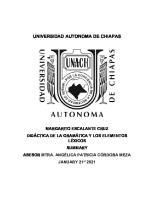Summary Phosphates: Deposits Of Non-Metallic Minerals
SUMMARY PHOSPHATES DEPOSITS OF NON- METALLIC MINERALS 14 DE ABRIL DEL 2018 VASQUEZ CASTILLO JORDY 20131387K PHOSPHAT
Views 189 Downloads 0 File size 455KB
Recommend stories
- Author / Uploaded
- Jordy
Citation preview
SUMMARY PHOSPHATES DEPOSITS OF NON- METALLIC MINERALS
14 DE ABRIL DEL 2018
VASQUEZ CASTILLO JORDY 20131387K
PHOSPHATES Sedimentation of phosphates in marine environments occurs in the area of continental shelf and deep cold conditions of ascending currents. The organic phosphorite precipitation occurs in cold environments, where ocean waters do not rise to shallow levels, by increasing pH and the partial pressure of CO2. Phosphate accumulation in the surface of the sea, the greater accumulation between 400m and 1000m depth, the transport of the cold continental shelf waters.Minerales importantes • Vivianite Fe2+3(PO4)2•8H2O • Piromorfite Pb5Cl(PO4)3 •Turquoise Cu2+Al6(PO4)4(OH)8• 4H2O • Apatite Ca5(PO4)3(F,Cl,OH) It is denominated Fluorapatito or simply Apatito to the varieties that contain fundamental fluorine, Chlorapatito when it is the chlorine element that intervenes in the formula and finally Hydroxilapatito when they are the predominant OH groups, forming between the three an isomorphic series. CO3 sometimes replaces PO3 (Carbonoapatito) and Mn sometimes Ca. The Francolita variety contains essentially F and OH .Genesis: • Orthymagmatic as accessory mineral of most igneous rocks. • Pegmatitis. • Associated with metamorphic rocks.
• By metasomatic replacement of limestones and dolomites by descending solutions (Phosphorites). • Sedimentation by biochemical mechanisms in marine waters (Fosforites). • Sedimentary in pleasures.
Types of deposits • Types of deposits • Phosphates of magmatic origin in alkaline rocks (Apato Ca5 [PO4] 3 (F, Cl, OH, O) and in deposits of iron of magmatic segregation. • Phosphates of marine origin deposits of continental shelf and of Geosinclinals. • Residual deposits: Phosphorus can be redeposited in cracks and karst cavities of mother rocks • Phosphates in guano: Organic matter and water 70%, P2O5 11%, CaO 10% (approx). Deposit of Peru: Holy Well • Bayovar • Ocucaje (oolitos)Applications: In the case of Apatite, the cryptocrystalline form (phosphorite) is used as fertilizer and in the chemical industry. Transparent crystals and beautiful colors are used as gems in spite of their low hardness. This phosphorite or phosphate rock is a material that is industrially processed for the manufacture of phosphorus fertilizer. The Monacita [(Ce, La, Y, Th) PO4], is another phosphate that is the main ore
of thorium (Th), radioactive element that is used to obtain atomic energy. Phosphates are the main industrial export rocks with 86.79% according to SUNAT - CUSTOMS - PERU 2014 BAYOVAR BAYOVAR • The most characteristic phosphate deposit in Peru is in Bayovar. The potential which has a 10000 MM MT grading 30% P2O5 and reserves = TM 262 Million to 30% P2O5. (Proved reservesand 460 24000 pot) • The laws that are concentrated in this site are from 29.2 to 31.8% and the head grade is 10 to 15%.
formed. That is why in the case of Peru if we find another like mentioned above would have to look at the site similar climatic conditions. Within Peru, we have the following formations phosphates: • Formation Zapallal upper Miocene • Formation Aramachay (Tri -. Jur) in the department of Junín, • Formation of the lower Liassic Sincos (Cockaigne) • Pisco Formation of Miocene • Miocene rocks holy well, • Cretaceous formations in the province of Yauli.
Due to the Coriolis effect may determine areas where phosphate deposits are
1. Facies de guijarrales y arenas de playa. 2. Facies fosfórica 3. Facies de sedimentos calcáreos 4. Inmersión de residuo de plancton 5. Dirección de las corrientes.
Fig. 1. Sedimentation of phosphates from seawater in the continental shelf area and in deep cold rising currents.









